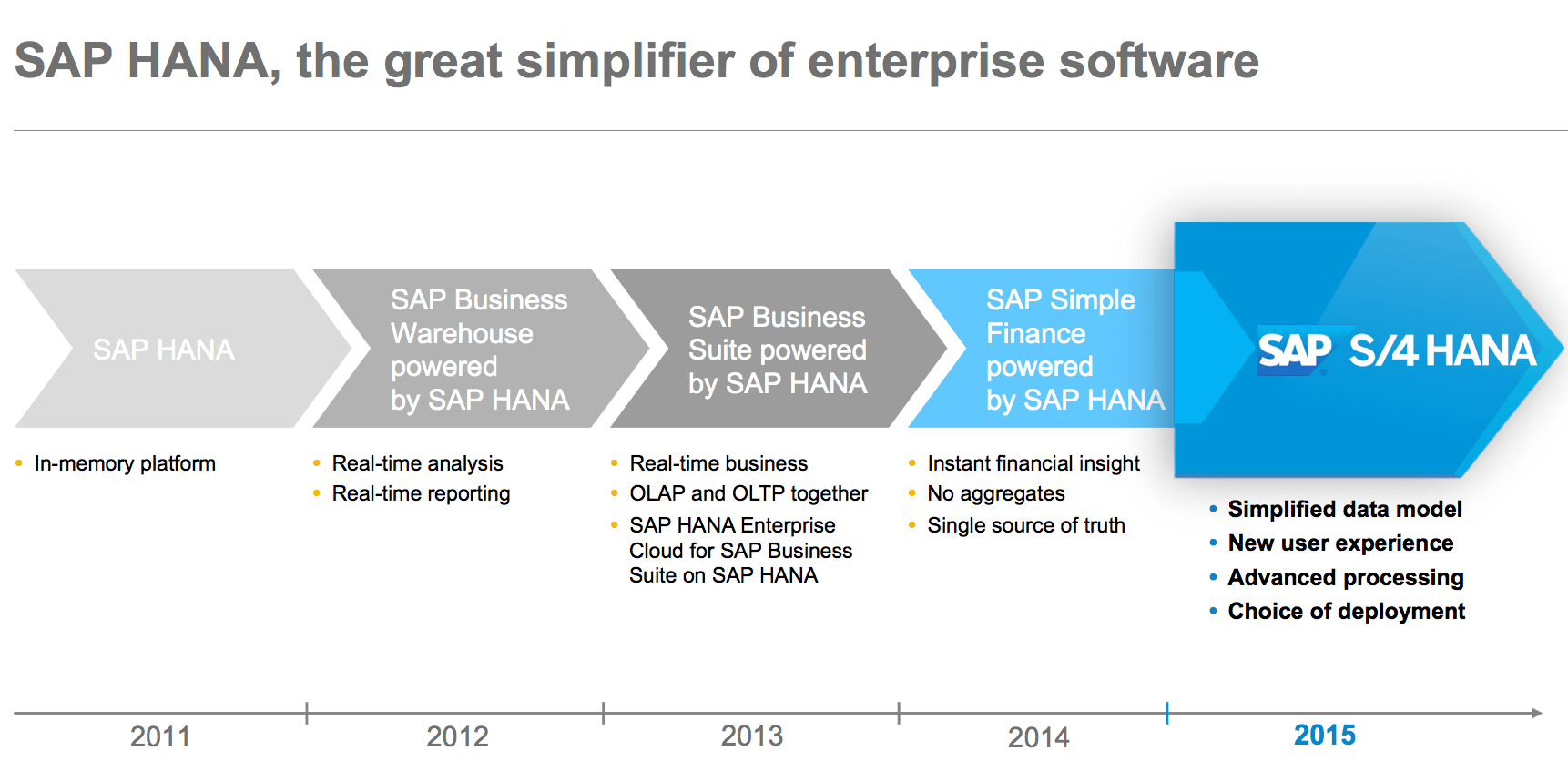Why Did SAP Fake S/4HANA Maturity So Aggressively?
Executive Summary
- S/4HANA was massively exaggerated in terms of maturity by SAP.
- The question answered by this article is why SAP did it.

Video Introduction: Why Did SAP Fake S/4HANA Maturity So Aggressively?
Text Introduction (Skip if You Watched the Video)
S/4HANA has had many implementation failures and is considered the riskiest of applications that we cover. It isn’t easy to see how a major new ERP version could be less successful than S/4HANA. Once you consider how falsified the S/4HANA go live numbers as we covered in How SAP Controls Perceptions with Numbers are and how most companies that have the S/4HANA license are not implementing it, you see a failed product launch. Those people that promoted S/4HANA look either inept or corrupt or both. You will learn about the technique that SAP and SAP consulting firms employed to fake S/4HANA’s maturity.
Our References for This Article
If you want to see our references for this article and other related Brightwork articles, see this link.
Notice of Lack of Financial Bias: We have no financial ties to SAP or any other entity mentioned in this article.
How SAP Introduced S/4HANA and its Completeness
Let us begin with how S/4HANA was introduced.
S/4HANA was explained as having two major phases of introduction. One was S/4HANA Simple Finance (which was the new FI/CO). SAP customers were told that the rest of the suite would follow shortly.
This second part did not happen, as stated by SAP. We covered the rest of the S/4HANA suite’s missed deadlines in the article The Evidence that S/4HANA Missed its Release Deadlines.

It is now going into 2018, and S/4HANA is still not complete. This means that companies that purchased SAP Simple Finance (now just Finance) under the impression that the rest of S/4HANA have a problem.
Becoming Increasingly Complete?
SAP has repeatedly released information that has attempted to make S/4HANA seem more complete than it is.
“If you look at the S/4HANA system that we released in November of last year that we are calling 1511, we can say that this is already a complete ERP system,” said Uwe Grigoleit, SAP global head of business development for Business Suite on HANA and HANA applications.”
“Why can we say this? If we are looking at pure modules we are shipping already, S/4HANA spans across financials, material management, inventory management, procurement, distribution, product and planning,” he explained. “It’s going across the vast majority of the ERP system already.”
That statement was made in March of 2016.
As we said at the time:
“This gets away entirely from the question of the completeness of each of these modules. Therefore, Uwe Grigoleit is staying away from whether the modules are complete. Uwe is stating that the modules are being released. But released is not necessarily complete.”
The Actual Story with S/4HANA’s Completeness
In our article Why the S/4HANA Suite is Not Yet Released, we explained.
“There has been and will continue to be a tremendous amount written about S/4 HANA. Interestingly there is lots of confusion as to what parts of S/4 HANA are ready to be implemented. SAP has misrepresented the readiness of S/4 HANA on just about every occasion, and it has an army of SAP partners that do the same.
This army is all about getting S/4 HANA implementation business, so they are actively misleading their prospects about S/4 HANA. Additionally, these partners are also misleading prospects about the consulting experience with S/4 HANA.”
The Attempt by SAP to Minimize the Issue with S/4HANA’s Completeness
SAP’s communication around S/4HANA’s timelines has been inaccurate since S/4HANA was first released. The lack of S/4HANA’s completeness has been a significant factor in why S/4HANA has so few go-lives globally, as is covered in the article A Study into S/4HANA Implementations. However, SAP can continue to predict future completed states without the worry of anyone publicly calling out SAP for this because virtually no one dares contradict SAP.
One example of the storyline of when S/4HANA will be complete is illustrated by an article that ComputerWeekly published in March of 2016 entitled SAP S/4HANA functional completeness in the eye of the beholder.
Before we analyze the article itself, let us explain what ComputerWeekly is.

ComputerWeekly used to be a legitimate IT magazine. However, in 2011 after they were demonetized due to publications moving to the Internet, TechTarget purchased them. TechTarget is primarily a marketing automation entity that uses various online websites like ComputerWeekly to capture email addresses sold to software vendors. TechTarget is just one of many media entities whose primary purpose is to promote IT company marketing interests in return for payment.
This is all covered in the article ComputerWeekly is a Front for Marketing Automation. This means that ComputerWeekly will publish whatever its customers, which are software vendors and consulting companies want them to publish.
Computer Weekly as a Passive Message Repeater of SAP
Now that we have explained ComputerWeekly as a passive message repeater for its customers, we can get into the interesting article SAP S/4HANA functional completeness in the eye of the beholder.
In this article, ComputerWeekly uses the following sources.
- SAP
- Jon Appleby (a puppet for SAP who runs Bluefin Solutions who distributes inaccurate and promotional information primarily about HANA, as we cover in the article How Jon Appleby Was So Wrong About His HANA Predictions)
In this article, Uwe Grigoleit presents a storyline where S/4HANA cannot be compared to ECC functionality.
“Along the way, SAP S/4HANA is also evolving beyond SAP Business Suite in capability, which in turn starts to change the nature of how you compare traditional Business Suite capabilities to new S/4HANA capabilities.”
Seeing Where Uwe Grigoleit is Going
See what Uwe is doing. S/4HANA’s functionality completeness would compare very poorly versus ECC, so Uwe’s simple answer is to do away with the comparison altogether because it’s “evolving beyond SAP Business Suite.” This is also curious because S/4HANA is exceptionally close to ECC functionality, except it has less of it.
Uwe is an expert at talking in circles, as the following quotations also attest.
“For something like maintenance, he said, SAP is changing classical maintenance with machine-to-machine communication, which helps generate “predictive maintenance scenarios.””
It should be clear from this that Uwe is a hype man, and one cannot discern anything from actually listening to Uwe.
Ding Ding Ding!

Uwe Grigoleit wins our coveted Golden Pinocchio award virtually every time he completes a sentence. He wins yet another one for his inverted and false explanation of how SAP moves to “machine-to-machine communication.”
John Appleby Enters the Funhouse
Next up is John Appleby, who ComputerWeekly or TechTarget does not explain, has a long history of making inaccurate SAP statements. Its incentives are to sell S/4HANA and HANA businesses. Yet ComputerWeekly or TechTarget provides no inkling to the reader of John Appleby’s background and history.

TechTarget did not think to consider what John Appleby’s financial bias may be. What has Appleby’s historical accuracy been, which we performed a study on in The Appleby Accuracy Checker: A Study into John Appleby’s Accuracy on HANA.
No, instead, TechTarget prints Appleby’s quotations.
However, there is no doubt that SAP told TechTarget that John Appleby is an approved source.
SAP determines which sources TechTarget “reporters” speak to. For example, Brightwork Research & Analysis is not an approved source, and SAP has told TechTarget authors not to take quotes from me. This also corresponds with BR&A being one of the few entities that cover SAP that has no financial connection to SAP. SAP only approves sources that it in some shape or form pays.
Let us review Appleby’s quote.
“In some cases, [you have to] wait 18 months and do a ‘big bang’ implementation, and in other cases [you can] start now, so we can phase the program. Every customer we’re working with is planning that journey to S/4HANA,” said Jon Appleby, global head of SAP HANA for Bluefin Solutions.
“I’ll give you an example,” Appleby explained. “I’m working with a U.S. customer in telecommunications, and the feds have told them they have to change the way they do revenue recognition, which they have to do before April of next year. They don’t think they can do what they need on Oracle, so they want to implement Suite on HANA, which will work well enough to do the new revenue recognition.”
Notice that Appleby accomplishes several things with this quote. First, he takes a dig at Oracle. He does this because Appleby’s company, Bluefin Solutions, primarily implements SAP. Appleby seems to be supporting the solution for which his company can make the most money.
How surprising.
What John Appleby Proposes
Appleby proposes that companies purchase and implement an application that is not ready to be implemented and that they push off the parts of S/4HANA that are not ready to later parts of the project.
However, what will the completed parts of the S/4HANA application connect to? Secondly, how does anyone know when S/4HANA will be complete? SAP has badly missed its deadlines up to this point.
And why is Appleby recommending this?
Did ComputerWeekly think for a minute that perhaps Jon Appleby has a financial bias in getting companies to use his services to implement S/4HANA? Is John Appleby trying to sell SAP consulting services and the benefits by implementing anything, even an immature application?
Appleby goes on to say.
“And what about SAP S/4HANA? “They’re saying, ‘We’ll deal with S/4HANA sometime later.”
So what Appleby is proposing is that customers implement the revenue recognition module first.
Then S/4HANA later.
But why does revenue recognition have to be implemented at all? Revenue recognition is supposed to be functional within the ECC FI/CO module.
ECC can be updated to the most current version, so why isn’t the latest revenue recognition logic included in this update?
“For a lot of customers who haven’t done a fast close, it’s a quick win. If your finance processes are a little outdated, you can get your finance enhancements all in one go,” Appleby said.
This statement gets into the claim of how S/4HANA speeds the reconciliation process. We have thoroughly analyzed this claim and found it utterly meritless, as we cover in the article Does HANA Have a Simplified Data Model and Faster Reconciliation?
Ding Ding Ding!

When Uwe Grigoleit and John Appleby are quoted in the same article, each receive a Golden Pinocchio Award.
And John Appleby is not the only individual pushing this narrative. I worked with a low-grade consulting firm obsessed with pushing SAP’s bizarre separate revenue recognition module (which is different from FI/CO for some mystery reason) to customers.
S/4HANA Finance Implemented by Itself???
If S/4HANA Finance is implemented without S/4HANA, expensive adapters must be written back to ECC and parts of ECC deactivated, and S/4HANA activated. Why does this give financial enhancement “all in one go?”
Appleby finishes off with a final touch.
So does it matter if SAP S/4HANA is functionally complete? Not necessarily, Appleby said, because each roadmap is unique. “They are all different because every company has different priorities.”
Interesting, so if the software promised in 2015 is still not ready, it is not necessarily a negative because companies have “unique requirements.”
Our Coverage of S/4HANA’s Maturity
We have covered this many times, but the IT media is more often than not receiving income from SAP. And therefore, there has been very little coverage of the completeness of S/4HANA. Previously we published the article Why the S/4HANA Suite is Not Yet Released.
Recently we found an article that looks quite suspicious to us and attempts to craft the storyline around S/4HANA in a deceptive way. In this article, we will explain how SAP coordinates and pays or compensates the media entity to distribute their story and how it then goes to sources that are compensated by SAP, all in an attempt to mislead buyers.
Where Did All the Pro-S/4HANA SAP Consultants Go?
Those SAP consultants have mostly disappeared from commenting on my shares on LinkedIn. When they start to bring up SAP’s talking points, I bring up the known history of these two products, and they gradually get exposed. They don’t like this. So they don’t comment on my articles anymore; instead, they are looking for soft targets. So they are saying the same things but to people that don’t research and don’t know.
How Did So Many Customers End Up With Unimplemented S/4HANA Licenses?
As time has progressed, the ratio of “live” S/4HANA customers to those that hold a license has been steady at roughly 1/5 of 20%. This is highly exaggerated as there are nowhere close to the number of live instances of S/4HANA that SAP claims.
SAP has stated that thousands of current S/4HANA implementations are underway, but job postings’ evaluation does not support this claim.
When SAP sold S/4HANA to many customers, they both knew they would not use it and pressured many customers to purchase S/4HANA to satisfy an indirect access claim or add it to the BOM of other products. This was done to exaggerate the numbers of S/4HANA sales to Wall Street and prospects. They would have to have known that a large percentage would fail if not most of those engaged in a S/4HANA implementation.
Why Such Extreme Fakery?
So why?
My conclusion is for short-term gain. Some executives need to get paid and show Wall Street they are making progress as soon as possible. Pulling S/4HANA forward or releasing it early enabled SAP to make a splash in the market earlier. However, they got caught with their pants down. This is because development has made so little progress since S/4HANA’s introduction. So it makes the initial statements around S/4HANA look even more inaccurate than the executives thought they were at the time. But when you gut your development and offshore a significant component of it, then there are consequences. SAP now has enormous numbers of low paid developers working on things.
Conclusion
Executive compensation and how SAP selects executives is critical to understanding how SAP made so many false statements around S/4HANA’s maturity. SAP selects only the most unrealistic executives, executives like Vishal Sikka, Bernd Leukert, Rob Enslin, Bill McDermott, Luca Mucic. People that will say anything without consideration for what is true.